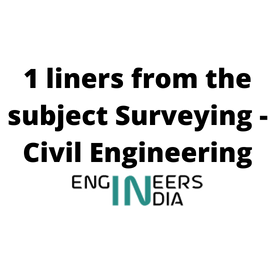1 liners from Surveying subject taken from the field Civil Engineering
Common 1 liners from Surveying
R.L. (Reduced Level)
- Any point's R.L. reflects its elevation (above or below 0 with respect to mean sea level as a datum).
Axis of the telescope
- The line that runs from the objective's optical core to the eyepiece's center.
Axis of the level tube
- At its mid-point, an imaginary line tangential to the tube's longitudinal curve.
Backsight
- Backsight is a reading taken by a staff member on a known elevation point.
Benchmark
- A benchmark is a known elevation above the datum that is fixed.
Datum
- A datum is a level surface (real or imagined) that is used as a reference.
Elevation
- The vertical distance above or below a datum is the elevation of a point/station on or near the earth's surface.
Height of instrument
- The height of the instrument, also known as HI the instrument's height, is the elevation of the telescope's line of sight.
Horizontal plane
- A plane can still be perpendicular to a plumb axis. It is perpendicular to a flat board.
Horizontal Line
- A horizontal line is one that is often perpendicular to a plumb line. It is perpendicular to a level axis. It can be found in the horizontal plane.
Horizontal distance
- Horizontal distance is the distance measured to a level line in plane surveying.
Intermediate sight
- The staff reading on a point other than the backsight and foresight of whose height is to be calculated is known as Intermediate Sight or IS.
Level surface
- An equipotential surface of the earth's gravitational field is a level surface. It's a curved surface with all of the elements perpendicular to the plumb axis. The simplest example of a level surface is a body of still water.
Level line
- At all points, the level line is a curved line that is parallel to plumb lines. Thus, it sits on a flat board.
Line of collimation
- The line that runs from the junction of the crosshairs to the objective's optical core and continues. Line of sight is another name for it.
Line of sight
- The junction of the crosshairs and the optical base of the objective lens is the line of sight.
Mean Sea level
- Mean sea level (MSL) is calculated by averaging the height of the sea's surface at all levels of the tides over an 18.6-year cycle. As a vertical datum level board, it is used. The MSL of Mumbai port is used as a reference surface for determining vertical height in India.
Plumb line
- It's the orientation of the earth's gravitational field's force lines. It is described in plane surveying by the position of a freely suspended plumb-bob.
Relative elevation
- The vertical distance between the level lines passing through two points is the difference in elevation between them.
Turning Point
- The turning point is a transitional/interval point between the setup of stations with both foresight and backsight readings.
Vertical plane
- It's a plane that runs parallel to a plumb axis. It's perpendicular to a horizontal plane.
Vertical line
- It's a line that runs parallel to a plumb line. It's perpendicular to a horizontal axis. It can be found in the vertical plane.
Vertical distance
- The distance measured along a plumb line is known as vertical distance.
Vertical Angle
- In a vertical plane, a vertical angle is an angle formed by two intersecting straight lines.
These are the 24 common important 1 liners from surveying, I hope you like reading this article.
Thanks,








No comments:
Post a Comment